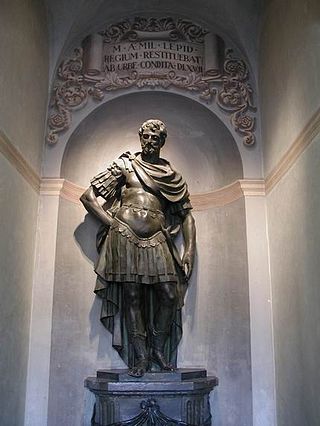
This article concerns the period 49 BC – 40 BC.
This article concerns the period 69 BC – 60 BC.
This article concerns the period 159 BC – 150 BC.
This article concerns the period 169 BC – 160 BC.
Year 63 BC was a year of the pre-Julian Roman calendar. At the time it was known as the Year of the Consulship of Cicero and Hybrida. The denomination 63 BC for this year has been used since the early medieval period, when the Anno Domini calendar era became the prevalent method in Europe for naming years.
Year 153 BC was a year of the pre-Julian Roman calendar. At the time it was known as the Year of the Consulship of Nobilior and Luscus. The denomination 153 BC for this year has been used since the early medieval period, when the Anno Domini calendar era became the prevalent method in Europe for naming years.
Year 157 BC was a year of the pre-Julian Roman calendar. At the time it was known as the Year of the Consulship of Caesar and Orestes and the Seventh Year of Houyuan. The denomination 157 BC for this year has been used since the early medieval period, when the Anno Domini calendar era became the prevalent method in Europe for naming years.
Year 160 BC was a year of the pre-Julian Roman calendar. At the time it was known as the Year of the Consulship of Gallus and Cethegus and the Fourth Year of Houyuan. The denomination 160 BC for this year has been used since the early medieval period, when the Anno Domini calendar era became the prevalent method in Europe for naming years.

Marcus Aemilius Lepidus was a Roman general and statesman who formed the Second Triumvirate alongside Octavian and Mark Antony during the final years of the Roman Republic. Lepidus had previously been a close ally of Julius Caesar. He was also the last pontifex maximus before the Roman Empire, and (presumably) the last interrex and magister equitum to hold military command.

The pontifex maximus was the chief high priest of the College of Pontiffs in ancient Rome. This was the most important position in the ancient Roman religion, open only to patricians until 254 BC, when a plebeian first held this position. Although in fact the most powerful office in the Roman priesthood, the pontifex maximus was officially ranked fifth in the ranking of the highest Roman priests, behind the rex sacrorum and the flamines maiores.

The gens Aemilia, originally written Aimilia, was one of the greatest patrician families at ancient Rome. The gens was of great antiquity, and claimed descent from Numa Pompilius, the second King of Rome. Its members held the highest offices of the state, from the early decades of the Republic to imperial times. The Aemilii were almost certainly one of the gentes maiores, the most important of the patrician families. Their name was associated with three major roads, an administrative region of Italy, and the Basilica Aemilia at Rome.
Marcus Aemilius Lepidus was a member of the Second Triumvirate alongside Octavian and Mark Antony.

Marcus Aemilius Lepidus was a Roman consul, Pontifex Maximus, Censor and Princeps Senatus. A scion of the ancient Patrician gens Aemilia, he was most likely the son of Marcus Aemilius Lepidus, with his brothers being Lucius and Quintus.

Lucius Aemilius Paullus was a Roman politician. He was the brother of triumvir Marcus Aemilius Lepidus and son to Marcus Aemilius Lepidus the consul of 78 BC. His mother may have been a daughter of Lucius Appuleius Saturninus.
Publius Mucius Scaevola was a prominent Roman politician and jurist who was consul in 133 BC. In his earlier political career he served as tribune of the plebs in 141 BC and praetor in 136 BC. He also held the position of pontifex maximus for sixteen years after his consulship. He died around 115 BC.
Marcus Aemilius Lepidus was a Roman consul for the year 158 BC, together with Gaius Popillius Laenas. He was a praetor in 161 or earlier, and was possibly the presiding praetor when the Senate was holding discussions on the dispute between Magnesia and Priene. He is mentioned in a context that suggests he was one of the Decemviri sacris faciundis, a priestly college (collegium) who oversaw the Sibylline Books in 143.
Quintus Lutatius Catulus Capitolinus was a politician in the late Roman Republic. His father was the like-named Quintus Lutatius Catulus, consul in 102 BC. He gained the agnomen "Capitolinus" for his defense of the capital in 77 BC against Lepidus.
Marcus Aemilius Lepidus was the Roman consul for 232 BC, and according to Livy served again as suffect consul, possibly in 221.
Servius Cornelius Lentulus Maluginensis was a Roman statesman, who flourished during the reigns of Augustus and Tiberius. He was flamen dialis, and consul suffectus in AD 10.





